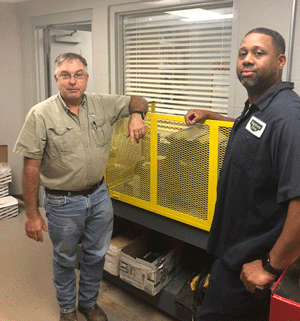
Written by: Sarah Novak | September 23, 2019

“Safety first!” This age-old adage rings just as true today as it did when it originated in the 1900s. The American Feed Industry Association recently asked a few of its members to discuss how they make sure safety always comes first, especially when onboarding new employees.
I had a chance to speak with William Bray, Facility Manager of Sanderson Farms, Kirk Bowman, Director of Operations of Performix Nutrition Systems and Kurt Marthaler, Vice President, Business Manager of Famo Feeds about the importance of safety at their facilities. Read what they had to say!
Q: What does safety culture mean to you and your company?
Bray: For us, our overall culture, and in particular safety culture, is “what you do when no one is looking.”
Bowman: The desired safety culture is where everyone understands that they are responsible for ensuring safety for themselves and their fellow workers. Our management provides the resources and sets the example that nothing moves forward unless it happens in a safe way. The staff adopts safe practices and are willing to hold each other accountable.
Marthaler: Safety culture at Famo Feeds means that all employees share in the responsibility of keeping the efforts and goals of the company’s health and safety program. We show deep concern for the employees’ well-being and this is reflected at all levels and departments within our company. Employees take workplace safety seriously, which translates into a safer work environment for everyone.

Q: How do you promote safety culture in your facility? And with new employees especially?
Bray: In short, by setting the example with my own actions. If I don’t do it safely, how can I expect others to do it?
Bowman: You talk about safety every chance you can. It may be a pre-work meeting because of a task that came up that day with potential safety issues. Monthly safety meetings or a toolbox meeting at a weekly department or standup meeting. Safety posters and signs can help staff be aware. Provide safety personal protective equipment and ensure that it is used correctly. Review safety incidents and accidents and perform a root-cause review of each event. These processes make staff drill down to what needs to change to improve safety.
New staff members should be informed and trained on the hazards and how to work safely before they perform their work. Don’t rely on a single training session to consider someone ready, but instead have them learn from a knowledgeable trainer, be shown how to do the task and then the new staff should show the trainer how it is done. Always address any variance from safe practices promptly, whether it is the new staff member or one that should know better.
Marthaler: Having a safety program in place that all employees are actively involved in. Performing periodic inspections and monthly, quarterly and annual training sessions keeps employees aware of the safety concerns at our facility. During these meetings, we discuss safety hazards and also praise employees for their positive safety behaviors. If there is an incident, we investigate it, make any changes in our safety procedures and retrain staff. We record each safety meeting and those records are reviewed annually.
All new employees must attend an orientation session with the safety coordinator where they walk through the safety policies and procedures and perform specialized training and testing for that individual’s specific job duties.

Q: What are the three steps to create a safety culture?
Bray:
Bowman:
Marthaler:
At AFIA, we are proud of the work that all of our members do in the area of employee safety. As you can see from the examples at Sanderson Farms, Performix Nutrition and Famo Feeds, each company strongly believes that safety is everyone’s business!
Comments See our policy on comments